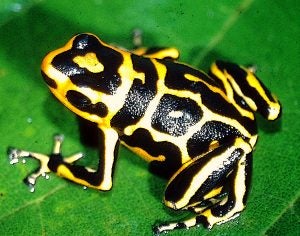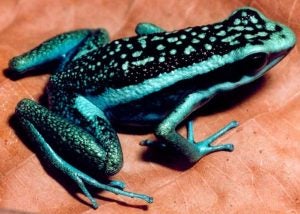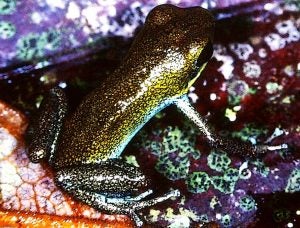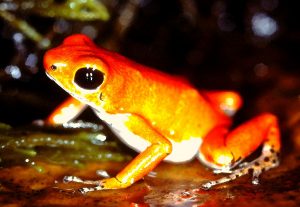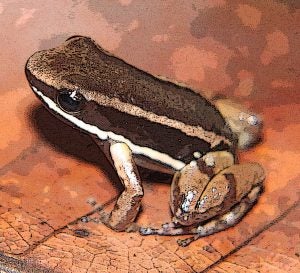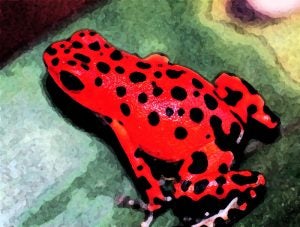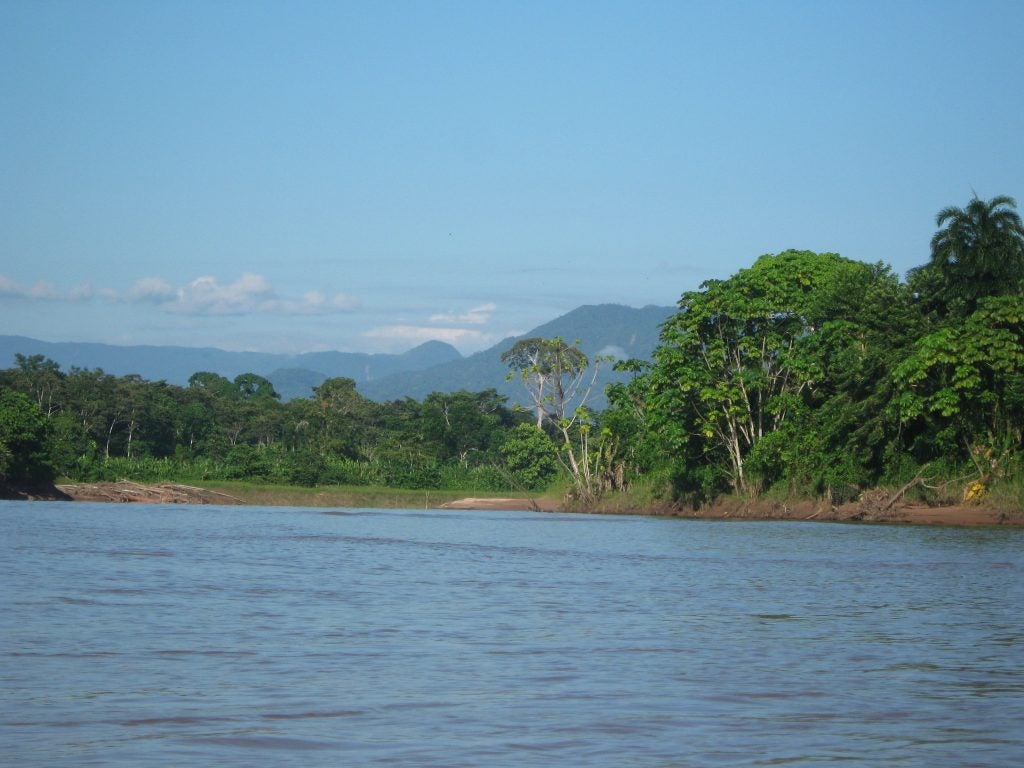
Welcome to the Summers Lab!
This page describes some of our research projects in the lab and in the field.
My Biology Department webpage (abit out of date at the moment) can be found here: http://www.ecu.edu/cs-cas/biology/summers_kyle.cfm
An older research webpage (designed and created by my former student, Evan Twomey) can be found here: http://core.ecu.edu/biol/summersk/summerwebpage/welcome.htm
For further information on my current and former students, please see:
Research Interests
I have broad interests in evolution, particularly evolutionary ecology and evolutionary genetics. My students and I have carried out research on reproductive strategies and larval life history in frogs. We have also worked on the evolution of aposematism and mimicry. I am interested in molecular systematics and the use of phylogenetic trees to inform analyses of ecology and adaptation. Evolutionary ecology and phylogenetics are complimentary, because it is important to consider the effects of ecology on adaptation in a historical context. Similarly, phylogenetic information can be used to investigate the influence of ecological and social factors on adaptation in comparative analyses. Most of our field and laboratory research has focused on the poison frogs of the family Dendrobatidae, a group of toxic frogs in Central and South America. These frogs vary in diet, coloration and toxicity, making them excellent candidates for research on aposematism and mimicry. The reproductive ecology of these frogs is also interesting and complex, involving territoriality, intra-sexual competition for mates, prolonged courtship, mate choice, long term associations between males and females, extensive parental care by one or both sexes, trophic egg-feeding, and larval cannibalism. The wide spectrum of variation in life histories across the poison frog family make this group an excellent system for comparative studies.
My students and I have carried out long-term field projects (ranging from months to years) in countries throughout Central and South America since 1985, including Costa Rica, Panama, Mexico, Venezuela, Ecuador and Peru. In the recent past most of our fieldwork has focused on the eastern cordilleras that mediate the transition between the Andes mountains and the Amazonian lowlands in Peru. This is one of the most biodiverse regions on earth, and this is particularly true for frogs. My students and I have worked up and down these cordilleras across the length of Peru sampling for biogeographic research. We have also carried out long-term field studies of the ecology of particular species in both northern and southern Peru.
I am also interested in evolutionary approaches to human health and behavior. Evolutionary biology is highly relevant to many issues crucial to human health and disease, yet few medical researchers take an evolutionary perspective. Vast amounts of data relevant to issues of central interest in evolutionary biology, such as the evolution of senescence and parasite-host coevolution, are being generated by biomedical researchers, but use of these data to test evolutionary hypotheses is uncommon. My collaborators and I have attempted to develop hypotheses relating specific conditions to environmental, social and genetic factors in an evolutionary framework. We are also attempting to test specific hypotheses using molecular evolutionary genetic analyses of genomic data available from public databases such as GenBank.
Below I briefly describe some of the main areas of research we have engaged in, with references and descriptions of media coverage.

Color pattern morph radiations: We have carried out genetic and phenotypic research on three explosive radiations of color pattern in poison dart frogs as examples of incipient speciation: Oophaga pumilio in the Bocas del Toro Archipelago in Panama, Ranitomeya imitator in San Martin, Peru, and Amereega bassleri on “sky peninsulas” in the central cordillera of Peru (Summers et al. 1997, 2003, 2004; Symula et al. 2001, 2003; Roberts et al. 2006b; Yeager et al. 2009; Wang and Summers 2010; Choteau et al. 2011, Richards-Zawacki et al. 2012; Gerhara et al. 2013; Twomey et al. 2013, 2014, 2016ab). A BBC television program (“Hidden Worlds”) about our research on O. pumilio was broadcast nationally on public television, and our population genetic research on this species was highlighted with an overview in Molecular Ecology in 2010.
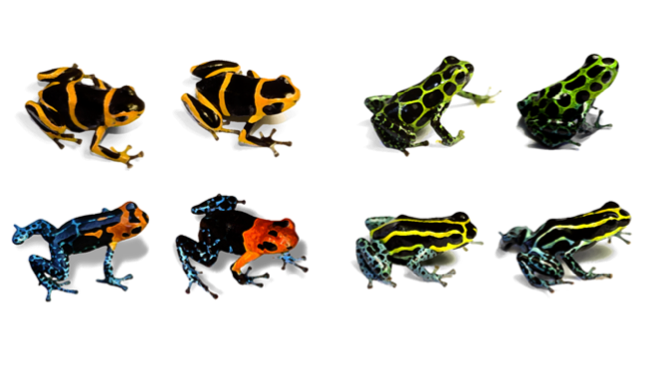
Aposematism, mimicry and the speciation continuum: Our lab was the first to use modern comparative methods (comparative analysis of independent contrasts) to demonstrate an evolutionary correlation between toxicity and bright coloration in any animal (Summers & Clough 2001). We were also the first to demonstrate Müllerian mimicry in frogs (Symula et al. 2001, 2003; Stuckert et al. 2014ab). We have done extensive research on the evolution of honest signaling in the context of aposematism (Summers et al. 2015; Stuckert et al. 2018). We have also carried out phenotypic and population genetic analyses of population divergence in a mimetic radiation (Yeager et al. 2012; Twomey et al. 2013), and provided evidence for incipient speciation driven by mimicry (Twomey et al. 2014, 2016ab). We are currently using genomic approaches to investigate the genetic basis of key traits (especially color pattern). In collaboration with Rasmus Nielsen at UC Berkeley and Matthew MacManes at the University of New Hampshire, we have been using genomic approaches (transcriptome sequencing and differential expression analysis, exome capture and sequencing, divergence and admixture mapping, pedigree analysis) to identify the genes underlying variation in color pattern in Ranitomeya imitator. Our work on speciation has been highlighted in multiple popular and academic venues including the Washington Post, the National Geographic Society and Current Biology.
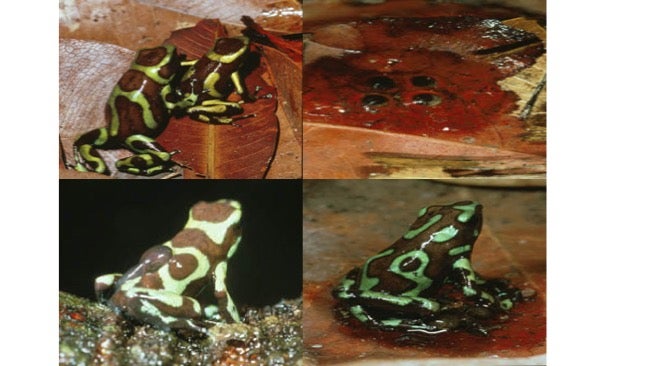
Evolution of parental care: We have carried out phylogenetic, comparative, theoretical and experimental analyses of the evolution of parental care in the Neotropical poison frogs (Summers 1992b; Summers et al. 1999), including a novel theoretical analysis of the evolution of female parental care from male care (Summers & Earn 1999). We have also carried out molecular evolutionary analyses of a gene affecting parental care in fish (Summers & Zhu 2008). Jesse Delia did an experiment demonstrating embryonic hatching plasticity in response to variation in male parental care (Delia et al. 2013, 2014). Film of the research on parental care in Dendrobates auratus was broadcast nationally in Britain and the US in a BBC series (“Sex: The Second Imperative”).

Sexual conflict: My research on mating strategies in Dendrobates auratus was one of the first studies demonstrating the relationship between variation in the quality of male parental care and sexual conflict among females (currently a hot topic in evolutionary ecology) (Summers 1989, 1990, 1992ab; Summers 2014). Highlighted in BBC Wildlife Magazine. Ranitomeya variabilis may also experience similar conflicts (Summers & Amos 1997).
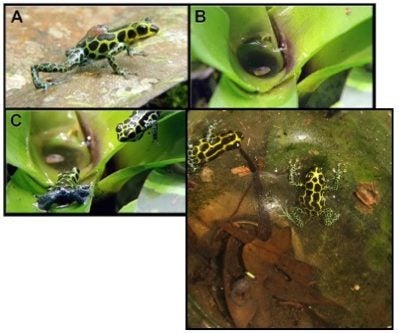
Evolutionary ecology of monogamy: We have provided behavioral, ecological, molecular genetic and comparative evidence establishing the clearest link between variation in a specific ecological factor (pool size) and the evolution of biparental care and monogamy in any animal (Brown et al. 2008ab, 2009a, 2010a; Tumulty et al. 2014). Our 2010 paper on monogamy in the mimic poison-dart frog, Ranitomeya imitator, in The American Naturalist was overviewed in Nature, Current Biology and Science Now, and covered on NPR, Discovery Channel Canada and the NY Times, among others. Film from our field site in Peru of biparental care in this monogamous species was included in the David Attenborough BBC program “Life in Cold Blood”, broadcast nationally in the UK and the USA.
Visual mate choice: We provided the first experimental demonstration of visual mate choice on the basis of color (spectral reflectance) in frogs (Summers et al. 1999). In collaboration with Tom Cronin (UMBC), we assisted with the first analysis of color perception in a Neotropical poison frog, using microspectrophotometry data on cone receptor classes (Siddiqi et al. 2004). We also demonstrated mate choice preferences associated with color pattern in the context of a mimetic radiation and incipient speciation (Twomey et al. 2014, 2016ab).
Honest signaling in aposematism and begging behavior: We used comparative methods to demonstrate a correlation between levels of toxicity and conspicuousness across Neotropical poison frogs (Summers & Clough 2001). We have investigated the application of honest signaling theory to the evolution of aposematism (Summers et al. 2015; Stuckert et al. 2018) and to tadpole begging behavior (Yoshioka et al. 2016).
Publications
Rubio, A.O, Dye, A., Ifill, K., Summers, K. 2024. On the wings of dragons: Morphometric differences between male and female common whitetail skimmer dragonfly (Plathemis lydia). PLoS ONE 19(5): e0303690. https://doi.org/10.1371/journal. pone.0303690.
Bieri, E., Rubio, A.O., Summers, K. 2024. Aggression within and between color morphs of the mimic poison frog: an experimental analysis. Evolutionary Ecology https://doi.org/10.1007/s10682-023-10285-x.
Weinfurther, K., Stuckert, A.M.M., Muscarella, M.E., Peralta, A.L., Summers, K. 2023. Evidence for a parabasalian gut symbiote in egg-feeding tadpoles of the Peruvian mimic poison frog. Evolutionary Biology 50: 239-258.
de Araujo, M.M., Stuckert, A.M.M., Johnson, M., Summers, K. 2023. Chromatophore types in different color morphs of the mimic poison frog: a histological analysis. PeerJ 11:e15533 https://doi.org/10.7717/peerj.15533.
Kikuchi, D. et al. 2023. The evolution and ecology of multiple antipredator defences. Journal of Evolutionary Biology 36: 375-391 (Invited review).
Stuckert, A.M.M. & Summers, K. 2023. Investigating signal modalities of aposematism in a poison frog. Journal of Evolutionary Biology 36:1003-1009. DOI10.1111/jeb.14111.
Crespi, B.J. Flinn, M., Summers, K. 2022. Runaway social selection in human evolution. Frontiers in Ecology and Evolution (10) 894506 (Invited Article). https://doi.org/10.3389/fevo.2022.894506.
Rubio, A.O. & Summers, K. 2022. Neural crest cell genes and the domestication syndrome: a comparative analysis of selection. PLoS ONE 17(2): e0263830. https://doi.org/10.1371/journal. pone.0263830.
Summers, K. & Summers, V. 2022. Concordant evidence for positive selection on genes related to self-domestication in bonobos and early humans. Evolutionary Behavioral Sciences 17(3): 322–332. http://dx.doi.org/10.1037/ebs0000290.
Schulte, L.M. & Summers, K. 2022. Who cares for the eggs? Analysis of egg attendance behaviour in Ranitomeya imitator, a poison frog with biparental care. Behaviour 159(7):603. 10.1163/1568539x-bja10142.
Davison, I., Saporito, R.A., Schulte, L. & Summers, K. 2022. Piperidine alkaloids from fire ants are not sequestered by the green and black poison frog (Dendrobates auratus). Chemoecology (2021) 31:391–396 https://doi.org/10.1007/s00049-021-00357-1.
Uetz P, Koo MS, Aguilar R, Brings E, Catenazzi A, Chang AT, Chaitanya R, Freed P, Gross J, Hammermann M, Hosek J, Lambert M, Sergi Z, Spencer CL, Summers K, Tarvin R, Vredenburg VT, Wake DB. 2021. A Quarter Century of Reptile and Amphibian Databases. Herpetological Review 52(2):246-255.
Stuckert, A.M.M., Chouteau, M., McClure, M., LaPolice, T. M., Linderoth, T., Nielsen, R., Summers, K., & MacManes, M. D. 2024. The genomics of mimicry: Gene expression throughout development provides insights into convergent and divergent phenotypes in a Müllerian mimicry system. Molecular Ecology, 30(16): 4039-4061. https://doi.org/10.1111/mec.16024.
Summers, K. 2021. Toxic jewels: poison frogs of the rainforest. 2021. Misc. Pub. U.Mich. Mus. Zool., Special Pub. No. 3.
Liu, Y., Jones, C.D., Day, L.B., Summers, K., Burmeister, S. 2020. Cognitive phenotype differential gene expression in a hippocampal homologue in two species of frog. Integrative and Comparative Biology. https://doi.org/10.1093/icb/icaa032.
Twomey, E., Kain, M., Claeys, M., Summers, K., Castroviejo-Fisher, S., Boxclaer, I.V.
2020. Mechanisms for color convergence in a mimetic radiation of poison frogs. American
Naturalist 195: doi:10.1086/708157.
Summers, K. 2019. Metabolism and parental care in ectotherms: Commentary on Beekman et al. Behavioral Ecology 30: 593-4.
Guillory, W.X., Muell, M.R., Summers, K., Brown, J.L. 2019. Conservation and phylogenomic reconstruction of the Neotropical poison frogs. Diversity 11: 126; https://doi.org/10.3390/d11080126 (Invited article).
Fischer, E.K., Benoit-Roland, A., Moskowitz, N.A. Tapia, E., Summers, K., Coloma, L.A., O’Connell, L.A. 2019. The neural basis of tadpole transport in poison frogs. Proceedings of the Royal Society of London, Series B 286: 20191084.
Liu, Y., Day, L., Summers, K., Burmeister, S. 2019. A cognitive map in a poison frog. Journal of Experimental Biology. 222:1-8.
Stuckert, A.M.M., Moore, E., Coyle, K.P., Davison, I., Roberts, R., MacManes, M.D., Summers, K. 2019. Variation in pigmentation gene expression is associated with distinct aposematic color morphs in the poison frog Dendrobates auratus. BMC Evolutionary Biology 19: 85. https://doi.org/10.1186/s12862-019-1410-7.
Young, R., Ferkin, M., Ockendon, N.F., Orr, V.N., Phelps, S., Pogany, A., Richards-Zawacki, C.L., Summers, K., Tzekely, T., Trainor, B., Urrutia, A.O., Zachar, G., O’Connell, L., Hoffman, H.A. 2019. Conserved transcriptomic profiles underpin monogamy across vertebrates. Proceedings of the National Academy of Sciences, USA 116:1331-1336.
Summers, K., Lahti, D., Braude, S., Strassmann, B., Strassmann, J. 2019. Obituary: The nine lives of Richard D. Alexander. Evolution and Human Behavior 40: 133-139.
Arthur, A., Terman, A., Kurzontkowski, C., Keene, K., Babatunde, T., Summers, K. 2018. Molecular evolution of genes associated with preeclampsia: genetic conflict, antagonistic coevolution and signals of selection. Journal of Evolutionary Medicine 6: 236038. doi:10.4303/jem/236038.
Rogers, R.L., Zhou, L., Chu, C., Marquez, R., Corl, A., Linderoth, T., Freeborn, L., MacManes, M.D., Xiong, Z., Zheng, J., Guo, C., Xun, X., Kronforst, M.R., Summers, K., Wu, Y., Yang, H., Richards-Zawacki, C.L., Zhang, G., Nielsen, R. 2018. Genomic takeover by transposable elements in the Strawberry poison frog. Molecular Biology and Evolution 35:2913–2927.
Stuckert, A.M.M., Saporito, R.A. & Summers, K. 2018. An empirical test indicates only qualitatively honest signaling within a population of vertebrates. Journal of Herpetology 52:201-208.
Schulte, L. and Summers, K. 2017. Searching for hormonal triggers: are vasotocin and mesotocin involved in parental care behaviors in poison frogs? Physiology and Behavior 174:74-82.
Schulte, L., Davison, I., Saporito, R.A., Summers, K. 2016. The unpalatability of poison frogs: do alkaloids make the difference? Biotropica 0:1-4.
Summers, K. 2016. Expanding investigations of manipulation via maternal effects: a comment on Paquet and Smiseth. Behavioral Ecology.
Yoshioka, M., Meeks, C., Summers, K. 2016. Evidence for begging as an honest signal in the Peruvian mimic poison frog. Animal Behaviour 113:1-11.
Liu, Y., Day, L.B., Summers, K., Burmeister, S.S. 2016. Serial reversal learning demonstrates behavioural flexibility in a poison frog. Animal Behaviour 111:167-172.
Twomey, E., Venegas, P., Summers, K. 2016. Acoustic divergence across populations in
the Peruvian mimic poison frog Herpetologica 71:252-259.
Twomey, E., Vestergaard, J.S., Venegas, P., Summers, K. 2016. Mimetic divergence and the speciation continuum in the mimic poison frog Ranitomeya imitator. American Naturalist 187:205-224.
Summers, K, Speed, M., Blount, J., Stuckert, A. 2015. Are aposematic signals honest? A review. Journal of Evolutionary Biology 28:1583-1599 (Invited review, cover photo).
Vestergaard, J.S., Twomey, E., Summers, K., Larsen, R., Nielsen, R. 2015. Number of genes controlling a quantitative trait in a hybrid zone. Proceedings of the Royal Society of London Series B 282:20141950.
Twomey, E., Vestergaard, J.S., Summers, K. 2014. Reproductive isolation related to mimetic divergence in the poison frog Ranitomeya imitator. Nature Communications 5:4749 (highlighted by National Geographic, overview in Current Biology)
Delia, J., Ramirez-Bautista, Summers, K. 2014. Glassfrog embryos hatch earlier after parental desertion. Proceedings of the Royal Society of London B 281:20133237 (Highlighted in Science and Live Science).
Stuckert, A., Saporito, R., Venegas, P., Summers, K. 2014. The toxicity of co-mimics in a putatively Müllerian mimetic radiation. BMC Evolutionary Biology 14:76.
Crespi, B.J., Summers, K. Inclusive fitness theory for the evolution of religion. 2014. Animal Behavior 92:313-323 (Invited article: Hamilton Symposium Volume).
Stuckert, A., Venegas, P., Summers, K. 2014. Experimental evidence for predator learning and Müllerian mimicry in Peruvian poison frogs (Ranitomeya, Dendrobatidae). Evolutionary Ecology 28:413-426.
Summers, K. Sexual conflict and deception in poison frogs. 2014. Current Zoology 60:37-42 (Invited article for a special issue on deception: highlighted in BBC Earth).
Tumulty, J., Morales, V., Summers, K. 2014. The biparental care hypothesis for the evolution of monogamy: experimental evidence in an amphibian. Behavioral Ecology 25:262-270 (Editor’s choice for best article).
Gehara, M., Summers, K., Brown, J.B. 2013. Population expansion, isolation and selection: novel insights on the evolution of coloration in the strawberry poison frog. Evolutionary Ecology 27:797-824 (Invited article for the Poison Frog Symposium Volume).
McKeon, C.S., Summers, K. 2013. Predator driven reproductive behavior in a tropical frog. Evolutionary Ecology 27:725-737 (Invited article for the Poison Frog Symposium Volume).
Delia, J., Ramirez-Bautista, Summers, K. 2013. Parental care varies with climate in a Neotropical glassfrog. Behavioral Ecology and Sociobiology 67:557-569.
Kosch, T.A., Summers, K. 2013. The effect of contaminants on PCR assays of chytridiomycosis: an experimental evaluation of amelioration methods. Molecular Ecology Resources 13:230-236.
Bee, M., Schwartz, J.J., Summers, K. 2013. All’s well that begins Wells: celebrating “The Social Behavior of Anuran Amphibians” Animal Behavior 85:5-18.
Twomey, E., Yeager, J., Brown, J.L., Cummings, M., Morales, V., Summers, K. 2013. Phenotypic and genetic divergence among poison frog populations in a mimetic radiation. PLoS One 8: e55443. doi:10.1371/journal.pone.0055443.
Richards-Zawacki, C., Wang, I., Summers, K. 2012. Mate choice and the genetic basis for color variation in a polymorphic dart frog: Inferences from a wild pedigree. Molecular Ecology 21:3879-3892.
Yeager, J., Brown, J.L., Cummings, M., Morales, V., Summers, K. 2012. Testing for selection on color pattern in a Mimetic Radiation. Current Zoology 58:668-676 (Invited article for a special volume on mimicry)
Kosch, T.A., Morales, V., Summers, K. 2012. The prevalence of the chytrid fungus, Batrachochytrium dendrobatidis, throughout Peru. Herpetological Review 43:274-278.
Brown, J.L., et al. 2011. A taxonomic revision of the Neotropical poison frogs genus Ranitomeya (Amphibia, Dendrobatidae). Zootaxa 3083:1-120.
Sun, G., Yang, Z., Kosch, T.A., Summers, K., Huang, J. 2011. Horizontal gene transfer may explain the evolution of extreme virulence in the devastating amphibian chytrid fungus. BMC Evolutionary Biology 11:195 (http://www.biomedcentral.com/1471-2148/11/195).
Yeager, J.D., Wooten, C.W. & Summers, K. 2011. A new technique for the production of clay models for field studies. Herpetological Review.
Chouteau, M., Summers, K., Morales, V., Angers, B. 2011. Advergence in Müllerian mimicry: the case of the poison-dart frogs of Northern Peru revisited. Biology Letters 7:796-800.
Davenport, J. & Summers, K. 2011. Environmental influences on the evolution of egg and clutch size in salamanders. Phyllomedusa 9:87-98.
Summers, K. and Crespi, B. 2010. Xmrks the spot: life history tradeoffs, sexual selection and the evolutionary ecology of oncogenesis. Molecular Ecology 19:3022-3024.
Brown, J.L., Maan, M., Cummings, M., & Summers, K. 2010. Evidence for selection on coloration in Panamanian poison frogs: a coalescent-based approach. Journal of Biogeography 37:891-901.
Brown, J.L., Morales, V., Summers, K. 2010. A key ecological factor drove the evolution of biparental care and monogamy in an amphibian. American Naturalist 175:436-446. (Covered in Nature, Current Biology, Science Now and Discovery Magazine)
Wang, I. & Summers, K. 2010. Genetic structure is driven by phenotypic divergence rather than geographic isolation in the highly polymorphic strawberry poison-dart frog.Molecular Ecology 19:447-458 (highlighted in a companion overview article).
Brown JL, Chouteau M, Glenn T, Summers K 2009. The development and analyses of twenty‐one microsatellite loci for three species of Amazonian poison frogs. Conservation Genetic Resources 1: 149-151 DOI 10.1007/s12686‐009‐9036‐5
von May, R., Reider, K.E., Summers, K. 2009. Trophic interaction between tadpoles of a bamboo–breeding poison frog (Ranitomeya biolat) and a predaceous mosquito larvae (Toxorhynchites sp.). Journal of Freshwater Ecology 24:431-435.
Gray, H.M., Summers, K. & Ibanez, R.D. 2009. Kin discrimination in cannibalistic tadpoles of the green poison frog, Dendrobates auratus. Phyllomedusa 8:41-50.
Crespi, B., Summers, K. and Dorus, S. 2009. Positive selection of intellectual disability genes in Rho GTPase and DNA repair pathways. Evolutionary Applications 3:52-63.
Wang, I. & Summers, K. 2009. Highly polymorphic microsatellite markers for the highly polymorphic strawberry poison-dart frog and some of its congeners. Conservation Genetics 10:2033–2036.
von May, R., Donnelly, M.A., Medina-Muller, M. & Summers, K. 2009. Breeding-site selection by poison frogs (Ranitomeya biolat) in Amazonian bamboo forests: an experimental approach. Canadian Journal of Zoology 87:1-11.
Brown, J.L., Morales, V. & Summers, K. 2008. Home range size and location in relation to reproductive resources: a Monte Carlo approach using GIS data. Animal Behavior 77:547-554.
Brown, J.L., Morales, V. & Summers, K. 2009. Tactical reproductive parasitism via larval cannibalism in Peruvian poison frogs. Biology Letters 5:148-151. Covered on Canadian National Radio (Quirks and Quarks)
Santos, J.C., Coloma, L.A., Summers, K., Caldwell, J.P., Ree, R. & Cannatella, D.C. 2009. Amazonian amphibian diversity is primarily derived from late Miocene Andean lineages. PLoS Biology 7: e1000056. doi:10.1371/journal.pbio.1000056.
Crespi, B., Summers, K. and Dorus, S. 2009. Genomic sister-disorders of neurodevelopment: an evolutionary approach. Evolutionary Applications 2:81-100 (invited article).
Summers, K., Roney, K., da Silva, J., Capraro, G., Cuthbertson, B., Rosenthal, G., Ryan, M., Kazianis, S. & McConnell, T. M. 2009. Evolutionary dynamics of the DAB and DXB
MHC II loci in Xiphophorus fishes. Genetica 135:379-390.
Brown, J.L., Morales, V., & Summers, K. 2008. Divergence in parental care, habitat selection and larval life history in two species of Peruvian poison frogs: an experimental analysis. Journal of Evolutionary Biology 21:1534-1543.
von May, R., Medina-Muller, M., Donnelly, M. & Summers, K. 2008. The tadpole of the bamboo–breeding poison frog Ranitomeya biolat (Anura: Dendrobatidae). Zootaxa 1857:66-68.
Twomey, E., Morales, V., & Summers, K. 2008. The effect of kinship on growth rate in Peruvian poison frogs. Phyllomedusa 7:119-124.
Summers, K. & Zhu, Y. 2008. Positive selection on a prolactin paralog following gene duplication in cichlids: adaptive evolution in the context of parental care? Copeia 2008 (4):873-877.
Summers, K. & Crespi, B.J. 2008. Molecular evolution of the prostate cancer susceptibility locus RNASEL: evidence for positive selection. Infection, Genetics and Evolution 8:297-301.
Twomey, E., Morales, V. & Summers, K. 2008. Evaluating condition-dependent and asymmetrical competition in a species-distribution context. Oikos 117:1175-1184.
Brown, J.L., Twomey, E., Morales, V. & Summers, K. 2008. Mating and parental care behaviors in relation to pool use in two species of Peruvian poison frogs. Behaviour 145:1139-1165.
Crespi, B.J., Summers, K., Dorus, S. 2007. Adaptive evolution of genes underlying schizophrenia. Proceedings of the Royal Society of London Series B 274:2801-2810. (Covered in the London Daily Telegraph and Scientific American)
Summers, K. & Crespi, B.J. 2007. The androgen receptor and prostate cancer: a role for sexual selection and sexual conflict? Medical Hypotheses 70:435-443.
Summers, K., McKeon, C.S., Heying, H., Hall, J., & Patrick, W. 2007. Social and environmental influences on egg size evolution in frogs. Journal of Zoology 271: 225-232.
Roberts, J.L., Brown, J.L., Schulte, R., Arizabal, W, and Summers, K. 2007. Rapid diversification of coloration among populations of a poison frog isolated on sky peninsulas in the central cordillera of Peru. Journal of Biogeography 34:417-426.
Roberts, J.L., Brown, J.L., von May, R., Arizabal, W., Schulte, R., Presar, A., Symula, R. & Summers, K. 2007. Phylogenetic relationships of the Neotropical poison frogs of the genus Dendrobates. Herpetological Journal 16:377-385.
Roberts, J.L., Brown, J.L., Arizabal, W., von May, R., Schulte, R., & Summers, K. 2006. Genetic divergence and speciation in lowland and montane Peruvian poison frogs. Molecular Phylogenetics and Evolution 41: 149-164.
Crespi, B. & Summers, K. 2006. Positive selection in the evolution of cancer. Biological Reviews 81: 407-424. (Overview in Scientific American)
Summers, K., McKeon, C.S. & Heying, H. 2006. The evolution of parental care and egg size: a comparative analysis in frogs. Proc. Royal Society of London, Series B 273: 687-692.
Brown, J.L., Schulte, R. & Summers, K. 2006. A new species of Dendrobates (Anura: Dendrobatidae) from the Amazonian lowlands in Perú. Zootaxa 1152: 45-58.
Crespi, B. and Summers, K. 2005. Evolutionary biology of cancer. Trends in Ecology and Evolution 20: 545-552.
Summers, K. and Crespi, B. 2005. Cadherins in maternal-foetal interactions: red queen with a green beard? Proceedings of the Royal Society of London, Series B 272:643-649.
Summers, K. 2005. The evolutionary ecology of despotism. Evolution and Human Behavior 26:106-135.
Siddiqi, A., Cronin, T.W., Loew, E.R., Vorobyev, M. & Summers, K. 2004. Interspecific and intraspecific views of color signals in the strawberry poison frog, Dendrobates pumilio. Journal of Experimental Biology 207:2471-2485.
Summers, K. & McKeon, C.S. 2004. The evolutionary ecology of phytotelmata use in poison frogs. Miscellaneous Publications of the Museum of Zoology of the University of Michigan 193:55-73.
Summers, K., Cronin, T.W., and Kennedy, T. 2004. Cross-breeding of distinct color morphs of the strawberry poison frog (Dendrobates pumilio) from the Bocas del Toro Archipelago, Panama. Journal of Herpetology 38:1-8.
Summers, K. 2003. Convergent evolution of bright coloration and toxicity in frogs. Proceedings of the National Academy of Sciences, USA 100:12533-12534.
Symula, R., Schulte, R. and Summers, K. 2003. Molecular systematics and phylogeography of the Amazonian poison frogs (genus Dendrobates). Molecular Phylogenetics and Evolution 26:452-475.
Summers, K., Cronin, T.W. and Kennedy, T. 2003. Color and pattern diversity in Dendrobates pumilio in the Bocas del Toro Archipelago, Panama. Journal of Biogeography 30:35-53.
Summers, K. et al. 2003. Parasitic exploitation as an engine of diversity. Biological Reviews 78:639-675.
Summers, K. 2002. Relative abundance of leaf litter anurans in primary forest in the Nusagandi Biological Reserve, Panama. Herpetological Natural History 9:69-73.
Summers, K. 2002. Forest for the frogs, frogs for the forest. Herpetological Review 33(1):16-18.
Summers, K. da Silva, J. and Farwell, M. A. 2002. Intragenomic conflict and cancer. Medical Hypotheses 59(2):170-179.
Symula, R., Schulte, R. and Summers, K. 2001. Molecular phylogenetic evidence for a mimetic radiation in Peruvian poison frogs supports a Müllerian mimicry hypothesis. Proceedings of the Royal Society of London, Series B 268: 2415-2421.
Summers, K. and Clough, M. 2001. The evolution of coloration and toxicity in the poison frogs. Proceedings of the National Academy of Sciences, USA 98(11):6227-6232.
Summers, K. and Symula, R. 2001. Cannibalism and kin discrimination in tadpoles of the Amazonian poison frog, Dendrobates ventrimaculatus, in the field. Herpetological Journal 11:17-21.
Summers, K. 2001. Iron, infection and the evolutionary ecology of heart disease. Medical Hypotheses 58(5):687-690.
Clough, M. and Summers, K. 2000. Phylogenetic systematics and biogeography of the poison frogs: evidence from mitochondrial DNA sequences. Biological Journal of the Linnaen Society 70(3): 515-540.
Summers, K., Holmes, K. and Boag, P. 2000. DNA fingerprinting in the minute poison frog, Minyobates minutus. Journal of Herpetology 34(2): 310-313.
Summers, K. 2000 Mating and aggressive behaviour in dendrobatid frogs from Corcovado National Park, Costa Rica: a comparative study. Behaviour 137: 7-24.
Summers, K., Symula, R., Clough, M. and Cronin, T.W. 1999. Visual mate choice in poison frogs. Proceedings of the Royal Society of London, Series B 266:1-5. (highlighted in the BBC television program “Hidden Worlds”)
Summers, K. 1999. The effects of cannibalism on Amazonian poison frog egg and tadpole deposition and survivorship in Heliconia axil pools. Oecologia 119:557-564.
Summers, K. 1999. Evolutionary psychology, birth order, and family dynamics. Trends in Ecology and Evolution 14(3):86-87.
Summers, K. 1999. Predation on Dendrobates auratus, the green poison frog, by spiders on Taboga Island, in Panama. Herpetological Review 30(2):91.
Summers, K. and Earn, D.J.D. 1999. The cost of polygyny and the evolution of female care in poison frogs. Biological Journal of the Linnaen Society 66:515-538.
Summers, K., Weigt, L.A., Boag, P. and Bermingham, E. 1999. The evolution of female parental care in poison frogs of the genus Dendrobates: evidence from mitochondrial DNA sequences. Herpetologica 55(2):254-270.
Summers, K. & Amos, W. 1997. Behavioral, ecological and molecular genetic analyses of reproductive strategies in the Amazonian dart-poison frog, Dendrobates ventrimaculatus. Behavioral Ecology 8:260-267.
Summers, K., Bermingham, E., Weigt, L., McCafferty, S. & Dahlstrom, L. 1997. Phenotypic and mitochondrial DNA divergence in three species of dart-poison frogs with contrasting parental care behavior. Journal of Heredity 88:8-13.
Tristem, M., Herniou, E., Summers, K. and Cook, J. 1996. Three retroviral sequences in amphibians are distinct from those in mammals and birds. Journal of Virology 70(7):4864-4870.
Summers, K. 1992. Mating strategies in two species of dart-poison frog: a comparative study. Animal Behaviour 43:907-919. (overview in BBC Wildlife Magazine)
Summers, K. 1992. Dart-poison frogs and the control of sexual selection. Ethology 91:2, 89-107.
Summers, K. 1990. Paternal care and the cost of polygyny in the green
dart-poison frog, Dendrobates auratus. Behavioral Ecology and Sociobiology 27: 307-313.
Summers, K. 1989. Sexual selection and inter-female competition in the green poison-dart frog, Dendrobates auratus. Animal Behaviour 37:797-805.
(highlighted in the BBC film series “Sex: the Second Imperative”).
